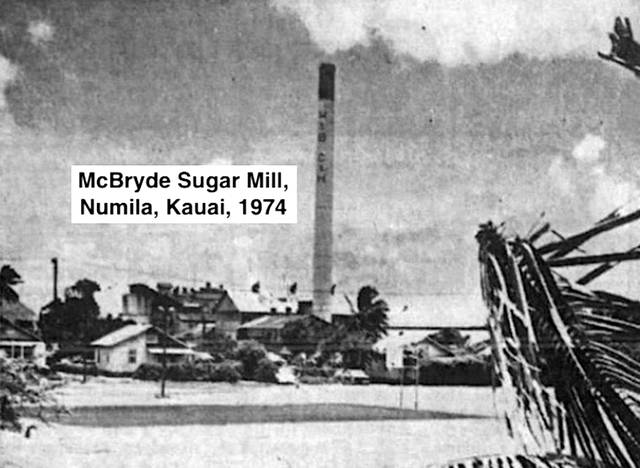In 1899, Eleele Plantation, the McBryde Estate and the Koloa Agricultural Company merged to create McBryde Sugar Co., which ground its first crop of sugarcane at the Eleele Plantation mill, located in the vicinity of today’s Eleele School.
Then in 1901, McBryde purchased its own mill — a mill originally destined for Molokai’s American Sugar Co. — to replace the smaller Eleele mill, and erected it on the flat plain halfway between the Wahiawa and Kalaheo gulches.
This was a new mill in relation to the older Eleele mill, and the plantation camp established next to it became known as New Mill, or Numila in Hawaiian, accordingly.
Seventy-three years later, in 1974, McBryde shut down its mill at Numila in favor of utilizing the Grove Farm Koloa mill it had leased from Grove Farm after Grove Farm ended its sugar operations in 1973.
Today, Kauai Coffee’s factory stands at Numila by the site where the McBryde Sugar mill once stood.
McBryde chose Grove Farm’s Koloa mill over its mill at Numila since it was better equipped to handle the increase in sugar acreage from 6,000 to 13,200 acres McBryde had obtained by also acquiring leases in 1973 to 7,200 acres of Grove Farm and Knudsen cane lands.
Furthermore, the Koloa Mill was more centrally located within McBryde’s sugar lands.
When McBryde terminated operations in 1996, the Koloa mill was shut down.
Also of note is the McBryde sugar mill smokestack, which for decades was a landmark used as a sighting point for vessels at sea.
The smokestack was 249 feet tall and was constructed of reinforced concrete in 1928 by the Webber Chimney Co. at a cost of $3,200.
By 1991, it hadn’t been in use since 1974 and its structure had weakened to the point that McBryde made the decision to hire the Mainland firm of Custodis-Cottrell to demolish it.
Contract workers made fast work of the upper 150 feet of the smokestack with jackhammers, but the thick concrete and heavy reinforcing iron of the lower 99 feet proved to be a difficult task.



After high school, I worked for McBryde Sugar in the harvesting department driving bulldozers. I remember the Koloa Mill had one of only two traffic lights, the other being at Kekaha. Almost hit some hippie guy driving a VW van at night when he ran the red light with a 10 ton truck pulling 2,000 gallons of water to keep the dust down at night.
Thank you again. Day. No one ever heard of your mayor or other stupid people rising up. 1948, those working at this plantation were the in thing. Harder workers and more productive than most laborers are today. Just comparing time frames.
My mother and her family lived on the plantation and my grandfather worked on the train. I am planning a trip in 2019 and was hoping I could visit and maybe get any information on my grandfather if possible? Who do I contact?
Julie Vellone
Thank you for this article. My paternal grandfather was chief engineer on the McBryde sugar plantation, and my grandmother was the 4th grade teacher and librarian at the Eleele school. Although my father permanently became a mainlander when he went to university and later established his aerospace career in southern California and eventually retired in Utah, people said he always brought the “aloha spirit” with him wherever he lived.
I’m working on an economic history of the Hawaiian sugar industry during the second industrial revolution. One thing in particular I’m attempting is to link 1914 data, anonymous, from the U.S. Department of Commerce to the names of the Hawaiian mills. If anybody has any cost or other data for mills on any of the islands around that time, I’d be highly grateful to learn of it. I hope to visit Hawaii soon, but of course have to wait for the coronavirus to tame down.
Dave Denslow denslow@ufl.edu
I highly recommend the book Grove Farm Plantation
I just found my paternal Great-Grandfather’s WWI draft registration and he lists New Mill, Ele’ele as his address. His family was from Madeira. My grandmother was born on Kauai, she was very proud of that. The family later went to CA and ended up in Massachusetts. His name was Manual F. Quintal Sr. I’d love to walk the land they walked someday.